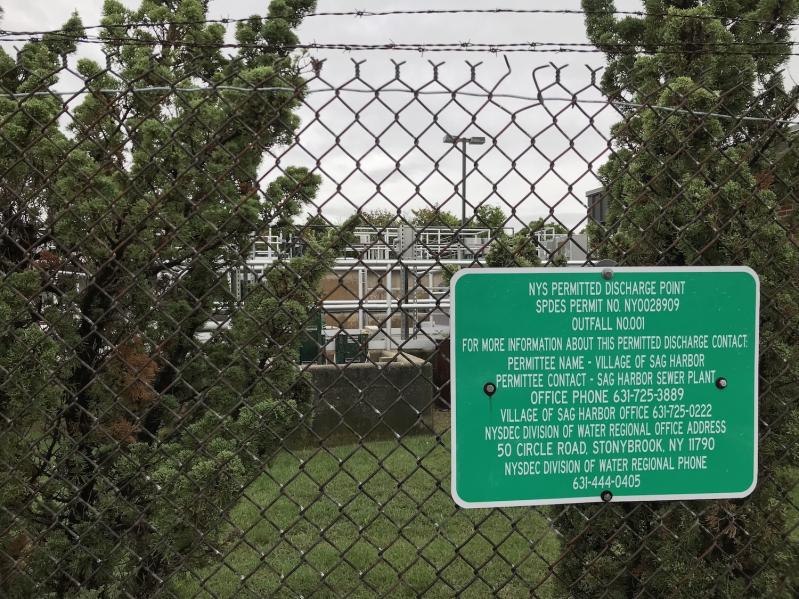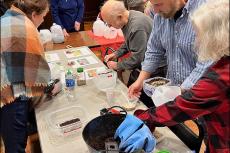In an attempt to secure the health of its waterways for future generations, Sag Harbor Village has hired an engineering firm to develop a master sewer plan that will connect more parcels to its wastewater treatment plant. The project’s estimated price tag? A whopping $78 million.
“We can’t get put off by the fact that this is an enormous, expensive project,” Aidan Corish, a village trustee, said during a meeting on Tuesday, Sept. 13. “We just take it one step at a time. It’s an existential situation for the village.”
In Sag Harbor Village, according to Mark Wagner, a principal wastewater manager with Cameron Engineering, the vast majority of properties rely on septic tanks and cesspools. Only 13 percent are connected to the sewage treatment plant, which was built in 1975. The plant had a pre-Covid peak of treating 150,000 gallons per day, but is sized for 250,000 gallons. The village now wants to assign about 90,000 gallons of that excess capacity to more parcels.
“Suffolk County is the septic tank capital of the world,” Mr. Wagner said. It fares slightly better than Sag Harbor, with 25 percent of properties across the county connected to sewers, while 75 percent use septic tanks and cesspools. “You won’t find that anywhere else in the country,” he said.
In July, East Hampton Village unveiled its own plans for a sewer system, which would go in under the long-term parking lot and cost $24 million. That plant would treat a minimum of 75,000 gallons of wastewater a day. It has been delayed pending approval by the State Department of Environmental Conservation.
“The primary mover of this study is the protection of the village waterways,” Mr. Wagner said, noting that water quality impacts the economy, tourism, and recreation.
According to the Stony Brook University Center for Clean Water Technologies, 70 percent of the excess nitrogen entering the village waterways comes from septic systems, while 30 percent comes from pesticides, fertilizers, stormwater, and other types of runoff.
Mr. Wagner said most of the village parcels that are hooked to the wastewater treatment plant are in the downtown and commercial area. To identify which new parcels were the highest priority to connect, they studied where groundwater is flowing and the topography of the village.
“One of the first things I learned in wastewater treatment is stuff runs downhill,” he said. Another important factor is travel time before the groundwater enters the village waterways. “If you’re down low, close to the harbor, it can get there in less than two years. Probably less than a year,” he said.
A decision was made to prioritize properties with septic runoff that enters the village waters the fastest.
Based on those and other factors, 16 “sewersheds” were identified and given a priority score. The two highest-priority areas, labeled “K” and “L” on the village’s plan, run roughly from West Water Street to the end of Marine Park. The village plans to discuss which properties are in each sewershed at future work sessions.
Mr. Wagner said the design work “is mostly done” for both the “K” and “L” sewersheds. This is important, he said, because when it’s time to compete for state or federal money, the municipality that’s ready to do the work usually gets the money.
In addition to hooking more village properties up to the current plant, Mr. Wagner wants to expand its capacity, enabling it to treat up to 320,000 gallons per day. New technologies that reduce nitrogen levels to less than 1 milligram per liter could also be implemented. There would be less nitrogen than in drinking water, “except you wouldn’t want to drink it,” he said. The federal Environmental Protection Agency’s limit for nitrates in drinking water is 10 milligrams per liter.
Mr. Wagner said that to pay for the infrastructure upgrades, the village might consider a “flush tax.” In Maryland, for example, to protect the Chesapeake Bay, the tax is approximately $50 a year. Mr. Corish said the current “sewer rent” for the properties hooked into the Sag Harbor treatment plant is $250 annually.
“That’s a pretty good deal compared to cable,” said Mayor Jim Larocca.
John Parker, a member of both the village’s harbor committee and sewer committee, said that while the presentation emphasized the water quality in the harbor, nitrogen in the groundwater is approaching a level that could make it unsafe to drink. Hooking up the “K” and “L” sections of the village might add only 40 more properties to the sewer system, but it would remove 2,600 pounds of nitrogen per year from groundwater.
“That’s a big impact,” Mr. Parker said. “Almost a car’s weight of nitrogen.”
Bob Plumb, a village trustee, noted that the wells from which the village draws its drinking water are much lower, “1,000 feet down into the aquifer.”
Mr. Wagner agreed, but said that background nitrate levels have been rising steadily over the last 50 years. “Whatever we do up top, ends up down in the bottom. . . . It all percolates down. It sometimes just takes a very long time.”
Tommy John Schiavoni, a Southampton Town councilman, said both drinking and harbor water matter. He noted that “this is the third straight year of 100-percent scallop die-off.” Long Island sits on a sole-source aquifer, meaning there is no “viable alternative for our drinking water.” Future generations are relying on us, he said.
“The goal is to get traction and have a package to hand off to future boards,” said Mr. Corish. “It might take 10, 15, or 20 years. But they say it’s like planting a tree. When is the best time? Twenty years ago, today.”




